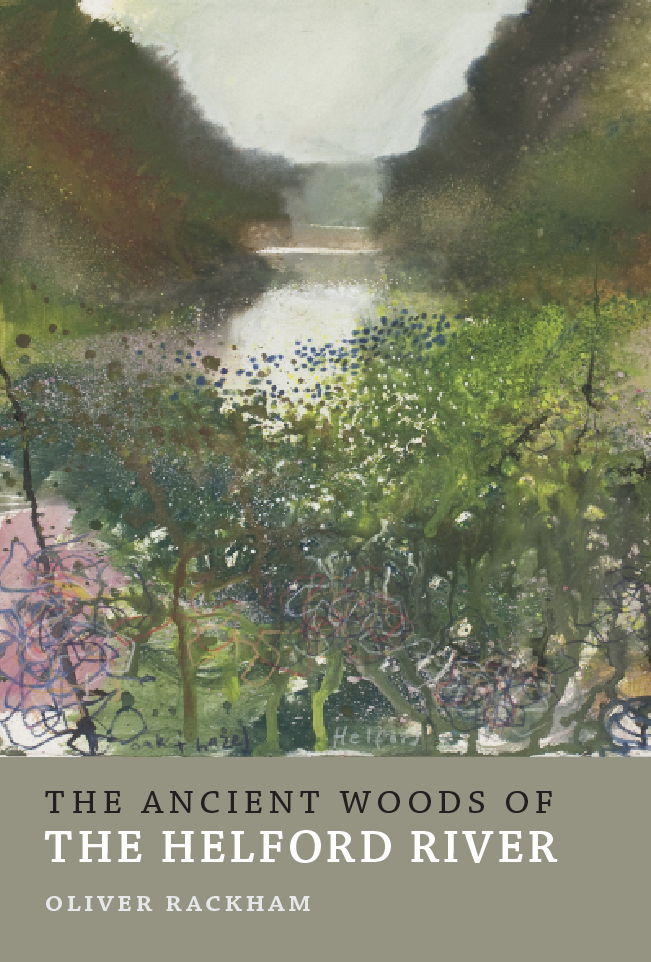The Helford River, Cornwall, is one of the very few places in England where ancient woodland meets the sea, and was beloved of the late, great botanist Oliver Rackham. Posthumously published by Little Toller, The Ancient Woods of the Helford River examines the geology, history and flora of twenty-five individual woods, and explains how these special places have survived the centuries – and what the future may hold for them. Philip Marsden reviews.

The Helford river is not actually a river but a tidal inlet that cuts five miles or so into the top of Cornwall’s Lizard peninsula. To see it properly, to glean the full mystique of its inner meanders, you must enter by boat. You must pass the semi-submerged August Rock and the shoreside settlement of Durgan, the twin ornamental gardens of Glendurgan and Trebah, push on past the villages of Helford Passage to the north and Helford itself to the south and then the villas west of Port Navas until the two shores narrow. There the houses grow fewer, the moored boats come to an end and you enter a timeless Heart-of-Darkness arena of twisting side-creeks and thick woodland whose bottom branches are all trimmed to the same spring-tide level.
In the sixteenth century, the remoteness of the Helford made it a favourite place for pirates to hide and strip plundered ships – so much so that it became known as ‘Stealford’. Now unused tracks, deep-cut and cave-like, lead down to abandoned quays; the traces of charcoal hearths and boundary walls remain half-hidden in the woods. And the woods themselves, once coppiced, harvested as commodity, bear the tantalising imprint of ages past. They are archaeology, revealing traces of the endeavours and values of our ancestors, with the added dimension of being a dynamic eco-system. No-one better then to unpick the clues than the greatest of our arboreal historians – Oliver Rackham, who died in 2015 and spent years and years visiting and revisiting Helford’s living tree museum.
The Ancient Woods of the Helford River, beautifully published here by Little Toller, is an account of Rackham’s findings. It is an example of place-led study, where the particular is used to reveal the general rather than the other way round, where a location is uncovered layer-by-layer, detail by detail until it appears with such clarity that the reader needs little leading to reach wider understanding.
Rackham chose his subject carefully. He was not immune to the evocative beauty of these woods but it was the trees and their ecology that really drew him. They are a fine example of the ‘western oakwood’, a biotope characteristic of the Atlantic seaboard of Britain and Europe, and dominated by sessile oak (quercus petraea) rather than the English or pedunculate oak (quercus robur). In the Helford they offer a rare juxtaposition of woodland and salt water.
But the real reward of the woods’ study lies in their timescale. Trees and woods do not operate in quarter-century slices like human generations, but in centuries. Rackham’s command of the story runs from the Pleistocene to the present. After the last ice age, he explains, trees re-colonised Britain from the south-east, over the land bridge from continental Europe. But oaks, he suggests, ‘seem to have appeared first in Cornwall, and spread north-east’. The Helford oaks have an ancient pedigree.
Discussion of their current state has much to teach us about how to maintain and restore – and create – semi-natural woodland. The ethos of rewilding is laissez-faire. In this case, such neglect will see an end to what these woods have been for so long. Beech trees in particular, introduced in eighteenth and nineteenth century plantings, are encroaching on the oaks, outcompeting them. Resuming a coppice cycle has been tried in the upper part of Tremayne Great Wood by the National Trust. But in the privately-owned woods, the time it requires is prohibitive.
For Rackham, planting trees was always the great no-no – upsetting the balance of species, importing disease with alien seedlings. His warnings from decades ago now look prescient in the face of so many arboreal ailments – more than twenty major diseases, according to the Woodland Trust, with another eleven about to arrive. Natural regeneration is to him the best way to create woodland. But it can take a hundred years or more for the full ecosystem to become established, with its ground flora and soil structure, its climax species, its mycorrhizal fungi.
Woodland and forest are not only perhaps the richest and most beautiful parts of our landscape, but also – on a global scale – the single most effective carbon sink. Studies like Rackham’s The Ancient Woods of Helford River reveal just how intricate they are, how much more than simply a collection of trees. If we are to preserve what we have, and increase it as we must, that intricacy should be understood.
*
The Ancient Woods of the Helford River is out now, priced £14.00. We have three copies to give away on tomorrow’s newsletter, kind courtesy of Little Toller. Make sure you’re signed up to our mailing list.
If you want to read more on the Helford river, might we suggest this extract from Peter Kirby’s contribution to our book A Collection of Words on Water.
Philip Marsden’s next book The Summer Isles: A Voyage of the Imagination is published by Granta on 3 October.